Nepal
Culture Name
Nepalese
Alternative Name
Nepali
Orientation
Identification. Nepal is named for the Kathmandu Valley, where the nation's founder established a capital in the late eighteenth century. Nepali culture represents a fusion of Indo-Aryan and Tibeto-Mongolian influences, the result of a long history of migration, conquest, and trade.
Location and Geography. Nepal is a roughly rectangular country with an area of 147,181 square miles (381,200 square kilometers). To the south, west, and east it is bordered by Indian states; to the north lies Tibet. Nepal is home to the Himalayan Mountains, including Mount Everest. From the summit of Everest, the topography plunges to just above sea level at the Gangetic Plain on the southern border. This drop divides the country into three horizontal zones: the high mountains, the lush central hills, and the flat, arid Terai region in the south. Fast-moving, snow-fed rivers cut through the hills and mountains from north to south, carving deep valleys and steep ridges. The rugged topography has created numerous ecological niches to which different ethnic groups have adapted. Although trade has brought distinct ethnic groups into contact, the geography has created diversity in language and subsistence practices. The result is a country with over thirty-six ethnic groups and over fifty languages.
Demography. The population in 1997 was just over 22.6 million. Although infant mortality rates are extremely high, fertility rates are higher. High birth rates in rural areas have led to land shortages, forcing immigration to the Terai, where farmland is more plentiful, and to urban areas, where jobs are available. Migration into cities has led to over-crowding and pollution. The Kathmandu Valley has a population of approximately 700,000.
Linguistic Affiliation. After conquering much of the territory that constitutes modern Nepal, King Prithvi Narayan Shah (1743–1775) established Gorkhali (Nepali) as the national language. Nepali is an Indo-European language derived from Sanskrit with which it shares and most residents speak at least some Nepali, which is the medium of government, education, and most radio and television broadcasts. For many people Nepali is secondary to the language of their ethnic group or region. This situation puts certain groups at a disadvantage in terms of education and civil service positions. Since the institution of a multiparty democracy in 1990, linguistic issues have emerged as hotly debated topics.
Symbolism. The culture has many symbols from Hindu and Buddhist sources. Auspicious signs, including the ancient Hindu swastika and Shiva's trident, decorate buses, trucks, and walls. Other significant symbols are the emblems (tree, plow, sun) used to designate political parties.
Prominent among symbols for the nation as a whole are the national flower and bird, the rhododendron and danfe; the flag; the plumed crown worn by the kings; and the crossed kukhris (curved knives) of the Gurkhas, mercenary regiments that have fought for the British Army in a number of wars. Images of the current monarch and the royal family are displayed in many homes and places of business. In nationalistic rhetoric the metaphor of a garden with many different kinds of flowers is used to symbolize national unity amid cultural diversity.
History and Ethnic Relations
Emergence of the Nation. Mongolian tribes from the east called Kiratis brought Buddhism in the seventh
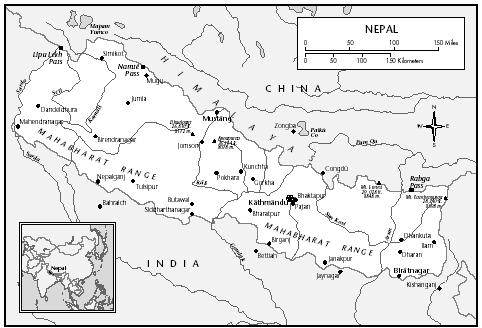
The birth of the nation is dated to Prithvi Narayan Shah's conquest of the Kathmandu Valley kingdoms in 1768. The expansionist reigns of Shah and his successors carved out a territory twice the size of modern Nepal. However, territorial clashes with the Chinese in the late eighteenth century and the British in the early nineteenth century pushed the borders back to their current configuration.
National Identity. To unify a geographically and culturally divided land, Shah perpetuated the culture and language of high-caste Hindus and instituted a social hierarchy in which non-Hindus as well as Hindus were ranked according to caste-based principles. Caste laws were further articulated in the National Code of 1854.
By privileging the language and culture of high-caste Hindus, the state has marginalized non-Hindu and low-caste groups. Resentment in recent years has led to the organization of ethnopolitical parties, agitation for minority rights, and talk about the formation of a separate state for Mongolian ethnic groups.
Despite ethnic unrest, Nepalis have a strong sense of national identity and pride. Sacred Hindu and Buddhist sites and the spectacular mountains draw tourists and pilgrims and give citizens a sense of importance in the world. Other natural resources, such as rivers and flora and fauna are a source of national pride.
Ethnic Relations. The population consists of numerous racial, cultural, and linguistic groups that often are divided into three broad categories: Indo-Nepalese, Tibeto-Nepalese, and indigenous Nepalese. The Indo-Nepalese migrated from India over several
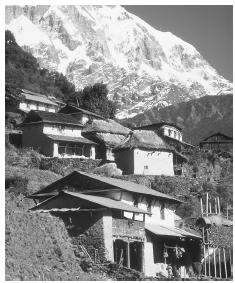
Hindu castes and Buddhist and animist ethnic groups were historically collapsed into a single caste hierarchy. At the top are high-caste Hindus. Below them are alcohol-drinking ( matwali ) castes, which include Mongolian ethnic groups. At the bottom are untouchable Hindu castes that have traditionally performed occupations considered defiling by higher castes. The Newars of the Kathmandu Valley have a caste system that has been absorbed into the national caste hierarchy.
Historically, members of the highest castes have owned the majority of land and enjoyed the greatest political and economic privileges. Members of lower castes have been excluded from political representation and economic opportunities. The untouchable castes were not permitted to own land, and their civil liberties were circumscribed by law. Caste discrimination is officially illegal but has not disappeared. In 1991, 80 percent of positions in the civil service, army, and police were occupied by members of the two highest castes.
Urbanism, Architecture, and the Use of Space
Nepal historically was one of the least urbanized countries in the world, but urbanization is accelerating, especially in the capital, and urban sprawl and pollution have become serious problems. Kathmandu and the neighboring cities of Patan and Bhaktapur are known for pagoda-style and shikhara temples, Buddhist stupas, palaces, and multistory brick houses with elaborately carved wooden door frames and screened windows. Although the largest and most famous buildings are well maintained, many smaller temples and older residential buildings are falling into disrepair.
At the height of British rule in India, the Rana rulers incorporated Western architectural styles into palaces and public buildings. Rana palaces convey a sense of grandeur and clear separation from the peasantry. The current king's palace's scale and fortress-like quality illustrate the distance between king and commoner.
Rural architecture is generally very simple, reflecting the building styles of different caste and ethnic groups, the materials available, and the climate. Rural houses generally have one or two stories and are made of mud brick with a thatched roof. Village houses tend to be clustered in river valleys or along ridge tops.
Food and Economy
Food in Daily Life. Many Nepalis do not feel that they have eaten a real meal unless it has included a sizable helping of rice. Most residents eat a large rice meal twice a day, usually at midmorning and in the early evening. Rice generally is served with dal, a lentil dish, and tarkari, a cooked vegetable. Often, the meal includes a pickle achar, made of a fruit or vegetable. In poorer and higher-altitude areas, where rice is scarce, the staple is dhiro, a thick mush made of corn or millet. In areas where wheat is plentiful, rice may be supplemented by flat bread, roti. Most families eat from individual plates while seated on the floor. Though some urbanites use Western utensils, it is more common to eat with the hands.
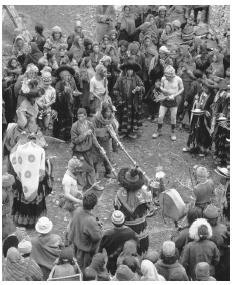
Conventions regarding eating and drinking are tied to caste. Orthodox high-caste Hindus are strictly vegetarian and do not drink alcohol. Other castes may drink alcohol and eat pork and even beef. Traditionally, caste rules also dictate who may eat with or accept food from whom. Members of the higher castes were particularly reluctant to eat food prepared by strangers. Consequently, eating out has not been a major part of the culture. However, caste rules are relaxing to suit the modern world, and the tourist economy is making restaurants a common feature of urban life.
Food Customs at Ceremonial Occasions. At weddings and other important life-cycle events, feasts are generally hosted by the families directly involved, and numerous guests are invited. At such occasions, it is customary to seat guests on woven grass mats on the ground outside one's home, often in lines separating castes and honoring people of high status. Food is served on leaf plates, which can be easily disposed of. These customs, however, like most others, vary by caste-ethnic groups, and are changing rapidly to suit modern tastes.
Basic Economy. The large majority of the people are subsistence farmers who grow rice, maize, millet, barley, wheat, and vegetables. At low altitudes, agriculture is the principal means of subsistence, while at higher altitudes agropastoralism prevails. Many households maintain chickens and goats. However, few families own more than a small number of cows, water buffalo, or yaks because the mountainous topography does not provide grazing land for large animals.
Nepal is one of the poorest countries in the world. This poverty can be attributed to scarce natural resources, a difficult terrain, landlocked geography, and a weak infrastructure but also to feudal land tenure systems, government corruption, and the ineffectiveness of development efforts. Foreign aid rarely goes to the neediest sectors of the population but is concentrate in urban areas, providing jobs for the urban middle class. The name of the national currency is rupee.
Land Tenure and Property. Historically, a handful of landlords held most agricultural land. Civil servants often were paid in land grants, governing their land on an absentee basis and collecting taxes from tenant-farming peasants. Since the 1950s, efforts have been made to protect the rights of tenants, but without the redistribution of land.
Overpopulation has exacerbated land shortages. Nearly every acre of arable land has been farmed intensively. Deforestation for wood and animal fodder has created serious erosion.
Commercial Activities. The majority of commercial activity takes place at small, family-owned shops or in the stalls of sidewalk vendors. With the exception of locally grown fruits and vegetables, many products are imported from India and, to a lesser extent, China and the West. Jute, sugar, cigarettes, beer, matches, shoes, chemicals, cement, and bricks are produced locally. Carpet and garment manufacturing has increased significantly, providing foreign exchange. Since the late 1950s, tourism has increased rapidly; trekking, mountaineering, white-water rafting, and canoeing have drawn tourists from the West and other parts of Asia. The tourism industry has sparked the commercial production of crafts and souvenirs and created a number of service positions, such as trekking guides and porters. Tourism also has fueled the black market, where drugs are sold and foreign currency is exchanged.
Major Industries. There was no industrial development until the middle of the twentieth century. Much of earliest industrial development was accomplished with the help of private entrepreneurs from India and foreign aid from the Soviet Union, China, and the West. Early development focused on the use of jute, sugar, and tea; modern industries include the manufacturing of brick, tile, and construction materials; paper making; grain processing; vegetable oil extraction; sugar refining; and the brewing of beer.
Trade. Nepal is heavily dependent on trade from India and China. The large majority of imported goods pass through India. Transportation of goods is limited by the terrain. Although roads connect many major commercial centers, in much of the country goods are transported by porters and pack animals. The few roads are difficult to maintain and subject to landslides and flooding. Railroads in the southern flatlands connect many Terai cities to commercial centers in India but do not extend into the hills. Nepal's export goods include carpets, clothing, leather goods, jute, and grain. Tourism is another primary export commodity. Imports include gold, machinery and equipment, petroleum products, and fertilizers.
Division of Labor. Historically, caste was loosely correlated with occupational specialization. Tailors, smiths, and cobblers were the lowest, untouchable castes, and priests and warriors were the two highest Hindu castes. However, the large majority of people are farmers, an occupation that is not caste-specific.
Social Stratification
Classes and Castes. Historically, caste and class status paralleled each other, with the highest castes having the most land, capital, and political influence. The lowest castes could not own property or receive an education. Although caste distinctions are no longer supported by law, caste relations have shaped present-day social stratification: Untouchables continue to be the poorest sector of society, while the upper castes tend to be wealthy and politically dominant. While land is still the principal measure of wealth, some castes that specialize in trade and commerce have fared better under modern capitalism than have landowning castes. Changes in the economic and political system have opened some opportunities for members of historically disadvantaged castes.
Symbols of Social Stratification. Caste and ethnic groups are often identifiable by both physical traits and styles of dress and ornamentation. These symbols of ethnic identity along with distinctive forms of music, dance, and cuisine, continue to be important. The culture of caste Hindus is the national
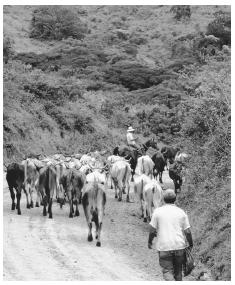
Political Life
Government. The Shah dynasty has ruled the country since its unification, except during the Rana period from the mid-nineteenth to the mid-twentieth century. During the Rana administration, the Shah monarchs were stripped of power and the country was ruled by a series of prime ministers from the Rana noble family. In 1950, the Shah kings were restored to the throne and a constitutional monarchy was established that eventually took the form of the panchayat system. Under this system, political parties were illegal and the country was governed by local and national assemblies controlled by the palace. In 1990, the Movement for the Restoration of Democracy (People's Movement) initiated a series of popular demonstrations for democratic reforms, eventually forcing the king to abolish the panchayat system and institute a multiparty democracy.
The country is divided administratively into fourteen zones and seventy-five districts. Local and district-level administers answer to national ministries that are guided by policies set by a bicameral legislature made up of a House of Representatives and a National Council. The majority party in the House of Representatives appoints the prime minister. The executive branch consists of the king and the Council of Ministers.
Leadership and Political Officials. The government is plagued by corruption, and officials often rely on bribes to supplement their income. It is widely believed that influence and employment in government are achieved through personal and family connections. The king is viewed with ambivalence. He and his family have been criticized for corruption and political repression, but photos of the royal family are a popular symbol of national identity and many people think of the king as the living embodiment of the nation and an avatar of the god Vishnu.
Social Problems and Control. International attention has focused on the plight of girls who have been lured or abducted from villages to work as prostitutes in Indian cities and child laborers in carpet factories. Prostitution has increased the spread of AIDS. Foreign boycotts of Nepali carpets have helped curb the use of child labor but have not addressed the larger social problems that force children to become family wage earners.
Military Activity. The military is small and poorly equipped. Its primary purpose is to reinforce the police in maintaining domestic stability. Some Royal Nepal Army personnel have served in United Nations peacekeeping forces. A number of Nepalis, particularly of the hill ethnic groups, have served in Gurkha regiments. To many villagers, service in the British Army represents a significant economic opportunity, and in some areas soldiers' remittances support the local economy.
Nongovernmental Organizations and Other Associations
Aid organizations are involved in health care, family planning, community development, literacy, women's rights, and economic development for low castes and tribal groups. However, many projects are initiated without an understanding of the physical and cultural environment and serve the interests of foreign companies and local elites.
Gender Roles and Statuses
Division of Labor by Gender. Only men plow, while fetching water is generally considered women's work. Women cook, care for children, wash clothes, and collect firewood and fodder. Men perform the heavier agricultural tasks and often engage in trade, portering, and other work outside the village. Both men and women perform physically demanding labor, but women tend to work longer hours, have less free time, and die younger. In urban areas, men are far more likely to work outside the home. Increasingly, educational opportunities are available to both men and women, and there are women in professional positions. Women also frequently work in family businesses as shopkeepers and seamstresses.
Children and older people are a valuable source of household labor. In rural families, young children collect firewood, mind animals, and watch younger children. Older people may serve on village councils. In urban areas and larger towns, children attend school; rural children may or may not, depending on the proximity of schools, the availability of teachers, and the work required of them at home.
The Relative Status of Women and Men. Women often describe themselves as "the lower caste" in relation to men and generally occupy a subordinate social position. However, the freedoms and opportunities available to women vary widely by ethnic group and caste. Women of the highest castes have their public mobility constrained, for their reputation is critical to family and caste honor. Women of lower castes and classes often play a larger wage-earning role, have greater mobility, and are more outspoken around men. Gender roles are slowly shifting in urban areas, where greater numbers of women are receiving an education and joining the work force.
Marriage, Family, and Kinship
Marriage. Nepal is overwhelmingly patrilineal and patrilocal. Arranged marriages are the norm in the mainstream culture. Because marriages forge important social bonds between families, when a child reaches marriageable age, the family elders are responsible for finding a suitable mate of the appropriate caste, education level, and social stratum.
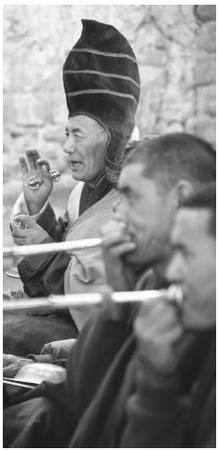
Hindu castes do not generally approve of cross-cousin marriage, which is preferred among some Mongolian ethnic groups. Among some groups, a brideprice substitutes for a dowry. In others, clan exogamy is an important feature of marriages. Until recently, polygyny was legal and relatively common. Now it is illegal and found only in the older generation and in remote areas. Child marriages were considered especially auspicious, and while they continue to be practiced in rural areas, they are now prohibited by law. Love marriage is gaining in popularity in the cities, where romantic films and music inform popular sentiment and the economy offers younger people economic independence from the extended family.
Domestic Unit. Among landholding Hindu castes, a high value is placed on joint family arrangements in which the sons of a household, along with their parents, wives, and children, live together, sharing resources and expenses. Within the household, the old have authority over the young, and men over women. Typically, new daughters-in-law occupy the lowest position. Until a new bride has produced children, she is subject to the hardest work and often the harshest criticism in her husband's household. Older women, often wield a great deal of influence within the household.
The emphasis in joint families is on filial loyalty and agnatic solidarity over individualism. In urban areas, an increasing number of couples are opting for nuclear family arrangements.
Inheritance. Fathers are legally obligated to leave equal portions of land to each son. Daughters do not inherit paternal property unless they remain unmarried past age thirty-five. Although ideally sons manage their father's land together as part of a joint family, familial land tends to be divided, with holdings diminishing in every generation.
Kin Groups. Patrilineal kin groups form the nucleus of households, function as corporate units, and determine inheritance patterns. A man belongs permanently to the kinship group of his father, while a woman changes membership from her natal kin group to the kin group of her husband at the time of marriage. Because family connections are critical in providing access to political influence and economic opportunities, marriage alliances are planned carefully to expand kinship networks and strengthen social ties. Although women join the husband's household, they maintain emotional ties and contact with their families. If a woman is mistreated in her husband's household, she may escape to her father's house or receive support from her male kin. Consequently, women often prefer to marry men from the same villages.
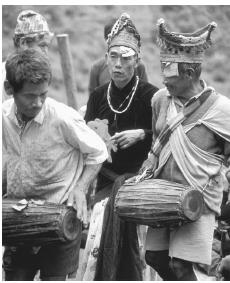
Socialization
Infant Care. Infants are carried on the mothers' back, held by a shawl tied tightly across her chest. Babies are breast-fed on demand, and sleep with their mothers until they are displaced by a new baby or are old enough to share a bed with siblings. Infants and small children often wear amulets and bracelets to protect them from supernatural forces. Parents sometimes line a baby's eyes with kohl to prevent eye infections.
Child Rearing and Education. Mothers are the primary providers of child care, but children also are cared for and socialized by older siblings, cousins, and grandparents. Often children as young as five or six mind younger children. Neighbors are entitled to cuddle, instruct, and discipline children, who are in turn expected to obey and defer to senior members of the family and community. Children address their elders by using the honorific form of Nepali, while adults speak to children using more familiar language. Because authority in households depends on seniority, the relative ages of siblings is important and children are often addressed by birth order.
Certain household rituals mark key stages in child's development, including the first taste of rice and the first haircut. When a girl reaches puberty, she goes through a period of seclusion in which she is prohibited from seeing male family members. Although she may receive special foods and is not expected to work, the experience is an acknowledgment of the pollution associated with female sexuality and reproductivity.
From an early age, children are expected to contribute labor to the household. The law entitles both girls and boys to schooling; however, if a family needs help at home or cannot spare the money for uniforms, books, and school fees, only the sons are sent to school. It is believed that education is wasted on girls, who will marry and take their wage-earning abilities to another household. Boys marry and stay at home, and their education is considered a wise investment.
Etiquette
The customary greeting is to press one's palms together in front of the chest and say namaste ("I greet the god within you"). Men in urban areas have adopted the custom of shaking hands. In the mainstream culture, physical contact between the sexes is not appropriate in public. Although men may be openly affectionate with men and women with women, even married couples do not demonstrate physical affection in public. Some ethnic groups permit more open contact between the sexes.
Hospitality is essential. Guests are always offered food and are not permitted to help with food preparation or cleaning after a meal. It is polite to eat with only the right hand; the hand used to eat food must not touch anything else until it has been thoroughly washed, for saliva is considered defiling. When drinking from a common water vessel, people do not touch the rim to their lips. It is insulting to hit someone with a shoe or sandal, point the soles of one's feet at someone, and step over a person.
Religion
Religious Beliefs. Eighty-six percent of Nepalis are Hindus, 8 percent are Buddhists, 4 percent are Muslims, and just over 1 percent are Christians. On a day-to-day level, Hindus practice their religion by "doing puja, " making offerings and prayers to particular deities. While certain days and occasions are designated as auspicious, this form of worship can be performed at any time.
Buddhism is practiced in the Theravadan form. There are two primary Buddhist traditions: the Buddhism of Tibetan refugees and high-altitude ethnic groups with cultural roots in Tibet and the Tantric form practiced by Newars.
There is a strong animistic and shamanic tradition. Belief in ghosts, spirits, and witchcraft is widespread, especially in rural areas. Spiteful witches, hungry ghosts, and angry spirits are thought to inflict illness and misfortune. Shamans mediate between the human and supernatural realms to discover the cause of illness and recommend treatment.
Religious Practitioners. Many forms of Hindu worship do not require the mediation of a priest. At key rites of passage such as weddings and funerals, Brahmin priests read Vedic scriptures and ensure the correct performance of rituals. At temples, priests care for religious icons, which are believed to contain the essence of the deities they represent. They are responsible for ensuring the purity of the temple and overseeing elaborate pujas.
Buddhist monasteries train young initiates in philosophy and meditation. Lay followers gain religious merit by making financial contributions to monasteries, where religious rites are performed on behalf of the general population. Within Buddhism there is a clerical hierarchy, with highly esteemed lamas occupying the positions of greatest influence. Monks and nuns of all ranks shave their heads, wear maroon robes, and embrace a life of celibacy and religious observance.
Rituals and Holy Places. Nepal occupies a special place in both Hindu and Buddhist traditions. According to Hindu mythology, the Himalayas are the abode of the gods, and are specifically associated with Shiva, one of the three principal Hindu deities. Pashupatinath, a large Shiva temple in Kathmandu, is among the holiest sites in Nepal and attracts Hindu pilgrims from all over South Asia. Pashupatinath is only one of thousands of temples and shrines scattered throughout Nepal, however. In the Kathmandu Valley alone, there are hundreds of such shrines, large and small, in which the major gods and goddesses of the Hindu pantheon, as well as local and minor divinities, are worshiped. Many of these shrines are constructed near rivers or at the base of pipal trees, which are themselves considered sacred. For Buddhists, Nepal is significant as the birthplace of Lord Buddha. It is also home to a number of important Buddhist monasteries and supas, including Boudha and Swayambhu, whose domeshaped architecture and painted all-seeing eyes have become symbols of the Kathamandu Valley.
Death and the Afterlife. Hindus and Buddhists believe in reincarnation. An individual's meritorious actions in life will grant him or her a higher rebirth. In both religions the immediate goal is to live virtuously in order to move progressively through higher births and higher states of consciousness. Ultimately, the goal is to attain enlightenment, stopping the cycle of rebirth.
In the Hindu tradition, the dead are cremated, preferably on the banks of a river. It is customary for a son to perform the funeral rites. Some Buddhists also cremate bodies. Others perform what are called "sky burials," in which corpses are cut up and left at sacred sites for vultures to carry away.
Medicine and Health Care
Infant mortality is high, respiratory and intestinal diseases are endemic, and malnutrition is widespread in a country where life expectancy is fifty-seven years. Contributing to this situation are poverty, poor hygiene, and lack of health care. There are hospitals only in urban areas, and they are poorly equipped and unhygienic. Rural health clinics often lack personnel, equipment, and medicines. Western biomedical practices have social prestige, but many poor people cannot afford this type of health care. Many people consult shamans and other religious practitioners. Others look to Ayurvedic medicine, in which illness is thought to be caused by imbalances in the bodily humors. Treatment involves correcting these imbalances, principally through diet. Nepalis combine Ayurvedic, shamanic, biomedical, and other systems.
Although health conditions are poor, malaria has been eradicated. Development efforts have focused on immunization, birth control, and basic medical care. However, the success of all such projects seems to correlate with the education levels of women, which are extremely low.
The Arts and Humanities
Literature. Nepal's literary tradition dates only to the nineteenth century with Bhanubhakta Acharya's adaptation of the Hindu epic, Ramayana, for a Nepali readership. The development of literature in Nepal has been hindered by heavy government control and censorship, which led Nepali authors and poets to seek publication outside of Nepal until the 1930s, when Nepal's first literary journal,
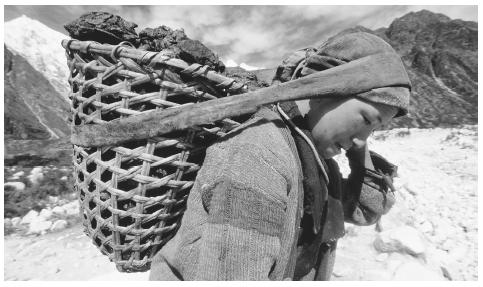
Graphic Arts. Much of Nepali art is religious. Newari artisans create cast-bronze statuary of Buddhist and Hindu deities as well as intricately painted tangkas that describe Buddhist cosmology. The creation and contemplation of such art constitutes a religious act.
Performance Arts. Dramatic productions often focus on religious themes drawn from Hindu epics, although political satire and other comedic forms are also popular. There is a rich musical heritage, with a number of distinctive instruments and vocal styles, and music has become an marker of identity for the younger generation. Older people prefer folk and religious music; younger people, especially in urban areas, are attracted to romantic and experimental film music as well as fusions of Western and Asian genres.
The State of the Physical and Social Sciences
Universities are underfunded, faculties are poorly paid, and library resources are meager. Nepalis accord less respect to degrees from universities than to degrees obtained abroad and many scholars seek opportunities to study overseas or in India. Despite these limitations, some fine scholarship has emerged, particularly in the social sciences. In the post-1990 period, political reforms have permitted a more open and critical intellectual environment.
Bibliography
Acharya, Meena, and Lynn Bennett. "The Rural Women of Nepal: An Aggregate Analysis and Summary of Eight Village Studies." The Status of Women in Nepal, 1981.
Adams, Vincanne. Tigers of the Snow and Other Virtual Sherpas: An Ethnography of Himalayan Encounters, 1996.
Ahearn, Laura Marie. "Consent and Coercion: Changing Marriage Practices Among Magars in Nepal." Ph.D. dissertation. University of Michigan, 1994.
Allen, Michael, and S. N. Mukherjee, eds. Women in India and Nepal, 1990.
Bennett, Lynn. Dangerous Wives and Sacred Sisters: Social and Symbolic Roles of High-Caste Women in Nepal, 1983.
Bista, Dor Bahadur. Fatalism and Development: Nepal's Struggle for Modernization, 1991.
Blaikie, Piers, John Cameron, and David Seddon. Nepal in Crisis: Growth and Stagnation at the Periphery, 1978.
Borgstrom, Bengt-Erik. The Patron and the Panca: Village Values and Pancayat Democracy in Nepal, 1980.
Borre, Ole, Sushil R. Pandey, and Chitra K. Tiwari. Nepalese Political Behavior, 1994.
Brown, T. Louise. The Challenge to Democracy in Nepal: A Political History, 1996.
Burghart, Richard. "The Formation of the Concept of Nation-State in Nepal." Journal of Asian Studies, 1984.
Cameron, Mary Margaret. On the Edge of the Auspicious, 1993.
Caplan, Lionel. "Tribes in the Ethnography of Nepal: Some Comments on a Debate." Contributions to Nepalese Studies 17 (2): 129–145, 1990.
Caplan, Patricia. Priests and Cobblers: A Study of Social Change in a Hindu Village in Western Nepal, 1972.
Des Chene, Mary. "Ethnography in the Janajati-yug: Lessons from Reading Rodhi and other Tamu Writings." Studies in Nepali History and Society 1: 97–162, 1996.
Desjarlais, Robert. Body and Emotion: The Aesthetics of Illness and Healing in the Nepal Himalaya, 1992.
Doherty, Victor S. "Kinship and Economic Choice: Modern Adaptations in West Central Nepal." Ph.D. dissertation. University of Wisconsin, Madison, 1975.
Fisher, James F. Sherpas: Reflections on Change in Himalayan Nepal, 1990.
Fricke, Tom. Himalayan Households: Tamang Demography and Domestic Processes, 1994.
——, William G. Axinn, and Arland Thornton. "Marriage, Social Inequality, and Women's Contact with Their Natal Families in Alliance Societies: Two Tamang Examples." American Anthropologist 95 (2): 395–419, 1993.
Furer-Haimendorf, Christoph von. The Sherpas Transformed. Delhi: Sterling, 1984.
——, ed. Caste and Kin in Nepal, India and Ceylon, 1966.
Gaige, Frederick H. Regionalism and National Unity in Nepal, 1975.
Gellner, David N., Joanna Pfaff-Czarnecka, and John Whelpton. Nationalism and Ethnicity in a Hindu Kingdom: The Politics of Culture in Contemporary Nepal, 1997.
Ghimire, Premalata. "An Ethnographic Approach to Ritual Ranking Among the Satar." Contributions to Nepalese Studie 17 (2): 103–121, 1990.
Gilbert, Kate. "Women and Family Law in Modern Nepal: Statutory Rights and Social Implications." New York University Journal of International Law and Politics 24: 729–758, 1992.
Goldstein, Melvyn C. "Fraternal Polyandry and Fertility in a High Himalayan Valley in Northwest Nepal." Human Ecology 4 (2): 223–233, 1976.
Gray, John N. The Householder's World: Purity, Power and Dominance in a Nepali Village, 1995.
Gurung, Harka Bahadur. Vignettes of Nepal. Kathmandu: Sajha Prakashan, 1980.
Hagen, Toni. Nepal: The Kingdom in the Himalayas, 1961.
Hitchcock, John. The Magars of Bunyan Hill, 1966.
Hofer, Andras. The Caste Hierarchy and the State in Nepal: A Study of the Muluki Ain of 1854, 1979.
Holmberg, David. Order in Paradox: Myth, Ritual and Exchange among Nepal's Tamang, 1989.
Hutt, Michael. "Drafting the 1990 Constitution." In Michael Hutt, ed., Nepal in the Nineties, 1994.
Iijima, Shigeru. "Hinduization of a Himalayan Tribe in Nepal." Kroeber Anthropological Society Papers 29: 43– 52, 1963.
Jones, Rex, and Shirley Jones. The Himalayan Woman: A Study of Limbu Women in Marriage and Divorce, 1976.
Justice, Judith. Policies, Plans and People: Culture and Health Development in Nepal, 1985.
Karan, Pradyumna P., and Hiroshi Ishii. Nepal: A Himalayan Kingdom in Transition, 1996.
Kondos, Alex. "The Question of 'Corruption' in Nepal." Mankind 17 (1): 15–29, 1987.
Kumar, Dhruba, ed. State Leadership and Politics in Nepal, 1995.
Landan, Perceval. Nepal, 1976.
Levine, Nancy. The Dynamics of Polyandry: Kinship, Domesticity, and Population on the Tibetan Border, 1988.
Levy, Robert I. Mesocosm: Hinduism and the Organization of a Traditional Newar City in Nepal, 1990.
Liechty, Mark. "Paying for Modernity: Women and the Discourse of Freedom in Kathmandu." Studies in Nepali History and Society 1: 201–230, 1996.
MacFarland, Alan. Resources and Population: A Study of the Gurungs of Nepal, 1976.
Manzardo, Andrew E. "To Be Kings of the North: Community, Adaptation, and Impression Management in the Thakali of Western Nepal." Ph.D. dissertation. University of Wisconsin, Madison, 1978.
Messerschmidt, Donald A. "The Thakali of Nepal: Historical Continuity and Socio-Cultural Change." Ethnohistory 29 (4): 265–280, 1982.
Molnar, Augusta. "Women and Politics: Case of the Kham Magar of Western Nepal." American Ethnologist 9 (3): 485–502, 1982.
Nepali, Gopal Singh. The Newars, 1965.
Oldfield, Henry Ambrose. Sketches from Nepal, Historical and Descriptive, 1880, 1974.
Ortner, Sherry B. High Religion: A Cultural and Political History of Sherpa Buddhism, 1989.
Pigg, Stacy Leigh. "Inventing Social Categories through Place: Social Representations and Development in Nepal." Comparative Studies in Society and History 34: 491–513, 1992.
Poudel, P. C., and Rana P. B. Singh. "Pilgrimage and Tourism at Muktinath, Nepal: A Study of Sacrality and Spatial Structure." National Geographical Journal of India 40: 249–268, 1994.
Regmi, Mahesh C. Thatched Huts and Stucco Palaces: Peasants and Landlords in 19th Century Nepal, 1978.
Rosser, Colin. "Social Mobility in the Newar Caste System." In Christoph von Furer-Haimendorf, ed. Caste and Kin in Nepal, India, and Ceylon, 1966.
Shaha, Rishikesh. Politics of Nepal, 1980–1991: Referendum, Stalemate, and Triumph of People Power, 1993.
Shrestha, Nirakar Man. "Alcohol and Drug Abuse in Nepal." British Journal of Addiction 87: 1241–1248, 1992.
Slusser, Mary S. Nepal Mandala: A Cultural Study of the Kathmandu Valley, 1982.
Stevens, Stanley F. Claiming the High Ground: Sherpas, Subsistence and Environmental Change in the Highest Himalaya, 1993.
Stone, Linda. Illness Beliefs and Feeding the Dead in Hindu Nepal: An Ethnographic Analysis, 1988.
Thompson, Julia J. "'There are Many Words to Describe Their Anger': Ritual and Resistance among High-Caste Hindu Women in Kathmandu." In Michael Allen, ed., Anthropology of Nepal: Peoples, Problems, and Processes, 1994.
Tingey, Carol. Auspicious Music in a Changing Society, 1994.
Vansittart, Eden. The Gurkhas, 1890, 1993.
Vinding, Michael. "Making a Living in the Nepal Himalayas: The Case of the Thakali of Mustang District." Contributions to Nepalese Studies 12 (1): 51–105, 1984.
—M ARIE K AMALA N ORMAN
Cordially,
Gerrie
Krishna Bista
ASU-Jonesboro, AR
what are the aestheric values of the people of Nepal?
and alsao the introduction to physical diversity in nepal
i wanna go back to nepal again and live there
at dahachok near west of Kathmandu Nepal and alsao the introduction to physical diversity in nepal
we are managing home stay tourism program at dahachok for you and your self
contact for - history, people, clothing, traditions, women, beliefs, food, customs, family
i hope this help to understand better.
anup
THANKS. BUT PLEASE REMEMBER WHEN YOU WRITE SOME LIKE THIS PLEASE BE FAIR AND DON'T TRY TO RACES AND WRITE ONLY TRUE THINGS ABOUT OTHER RELIGION WHICH YOU ARE NOT FALL IN THAT GROUP.
Thank you
Thank you so much.